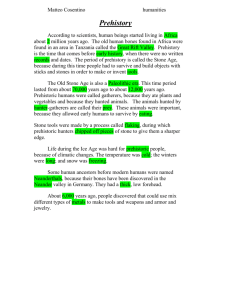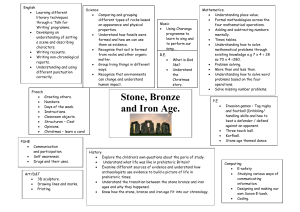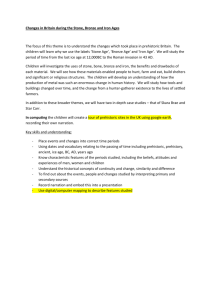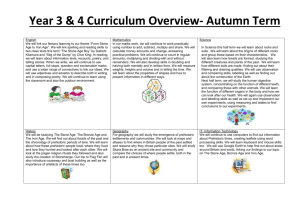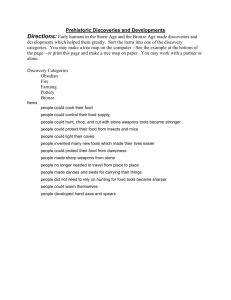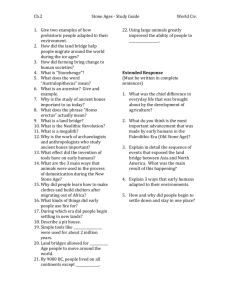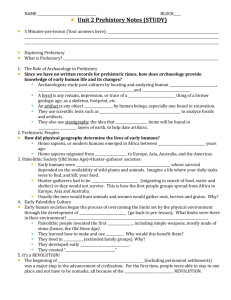0 1 Unit 1: Early Civilizations: PREHISTORY – A.D. 1570 Unit 1
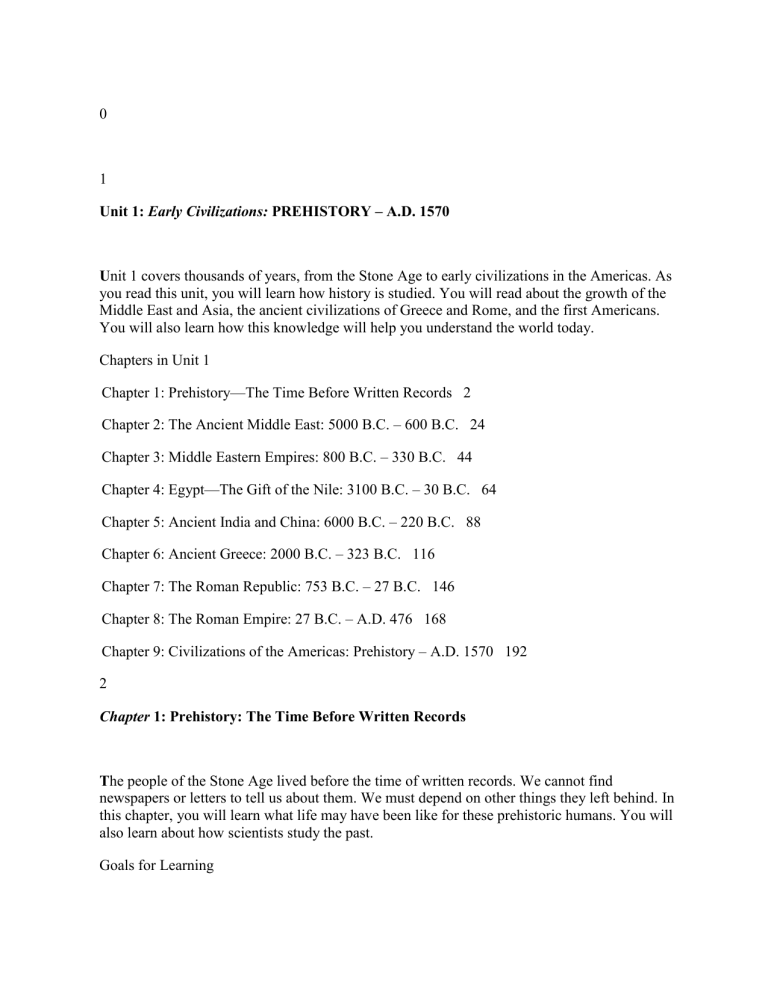
0
1
Unit 1: Early Civilizations: PREHISTORY – A.D. 1570
U nit 1 covers thousands of years, from the Stone Age to early civilizations in the Americas. As you read this unit, you will learn how history is studied. You will read about the growth of the
Middle East and Asia, the ancient civilizations of Greece and Rome, and the first Americans.
You will also learn how this knowledge will help you understand the world today.
Chapters in Unit 1
Chapter 1: Prehistory—The Time Before Written Records 2
Chapter 2: The Ancient Middle East: 5000 B.C. – 600 B.C. 24
Chapter 3: Middle Eastern Empires: 800 B.C. – 330 B.C. 44
Chapter 4: Egypt—The Gift of the Nile: 3100 B.C. – 30 B.C. 64
Chapter 5: Ancient India and China: 6000 B.C. – 220 B.C. 88
Chapter 6: Ancient Greece: 2000 B.C. – 323 B.C. 116
Chapter 7: The Roman Republic: 753 B.C. – 27 B.C. 146
Chapter 8: The Roman Empire: 27 B.C. – A.D. 476 168
Chapter 9: Civilizations of the Americas: Prehistory – A.D. 1570 192
2
Chapter 1: Prehistory: The Time Before Written Records
T he people of the Stone Age lived before the time of written records. We cannot find newspapers or letters to tell us about them. We must depend on other things they left behind. In this chapter, you will learn what life may have been like for these prehistoric humans. You will also learn about how scientists study the past.
Goals for Learning
To define history and describe two kinds of sources of information
To explain why we study history
To describe artifacts and what historians learn from them
To identify early hominids, the Stone Age, and the importance of farming
3
Skeleton Finds
Map Skills: We can use a map that shows direction to find where things are. When you face the direction of the North Pole, you face north. If you face the South Pole, you face south.
When you face north, east is to your right; west is to your left.
Most maps use a symbol to show where north is. From this information, you can figure out the three other directions. Note the direction symbol on this map. We call this symbol a compass rose.
The map on this page contains another symbol—a skull. It shows where archaeologists have found clues about early humans.
Study the map, then answer the following questions:
1. Which of the six pictured continents contains the skeleton find known as Marmes?
2. Which of the six pictured continents contains the skeleton find known as Krapina?
3. In what direction would you be traveling if you went from Monte Verde to Lake Mungo, passing through the Indian Ocean?
4. What skeleton finds are south of the imaginary line called the equator?
5. What skeleton finds are located farthest west on the map?
4
Reading Strategy: Summarizing
When readers summarize, they ask questions about what they are reading. As you read the text in this chapter, ask yourself the following questions:
Who or what is this chapter about?
What is the main thing being said about this topic?
What details are important to the understanding of this chapter?
Key Vocabulary Words
Lesson 1
History: The record of past events
Culture: The values, attitudes, and customs of a group
Historian: One who is an expert in history
Primary source: A first-hand account of a historical event
Secondary source: A second-hand account of a historical event; an account written by a person who was not there
Lesson 3
Archaeologist: A scientist who finds and studies the things people left behind
Artifact: An object made by a person for a practical purpose
Anthropologist: A scientist who studies the beginnings and the behavior of people
Radiocarbon dating: A way of measuring the radioactivity of historic artifacts to determine how old they are
Lesson 4
Prehistory: The time before humans left written records
Hominids: A group that includes humans and their closest relatives
Ice Age: A period of time when much of Earth and Earth’s water was frozen
Extinct: No longer existing; died out
Cro-Magnon: The hominid Homo sapiens , a direct ancestor of modern humans
Paleolithic Age: The earliest period of human history; called the Old Stone Age
Neolithic Age: The age when people made polished stone tools; also called the New Stone Age
Nomad: A person who moves from place to place
Monument: An object or building honoring a person or event, usually made of stone
Civilization: A large group of people who have cities and government, and a high level of
development as a group
5
Lesson 1: The Meaning of History
Objectives
To define history
To identify the differences between primary and secondary sources
To understand why people interpret history differently
History
The record of past events
Culture
The values, attitudes, and customs of a group
Historian
One who is an expert in history
Primary source
A first-hand account of a historical event
Secondary source
A second-hand account of a historical event
History is the record of past events. It is the story of people and what happened to them. Each group of people has its own history. In this book, you will learn about the combined history of all people—the history of humanity.
Why Do We Study History?
The people who lived before you learned many lessons they could share with you. Imagine knowing nothing about those people. You would have to learn all their lessons for yourself. If this happened, history would be dead. But happily, history is alive and well! It lives in our culture , or our values, attitudes, and customs. It can teach us its lessons.
What Are Primary Sources and Secondary Sources?
When writing history, historians —experts in history—ask themselves: What happened? When and where did it happen? Who was involved? Why did it happen? To find answers, they look for primary sources . These sources are first-hand, or eyewitness, accounts of the event. They also seek out secondary sources , or second-hand records of what happened. These accounts are written by a person who was not there.
Imagine an argument in the school cafeteria. It will show you the difference between these two sources. You see the argument, so you are an eyewitness. That makes you a primary source.
You tell someone about the argument. That person is not an eyewitness. That person becomes a secondary source.
6
Reading Strategy: Summarizing
How does this lesson help you understand what you will be studying in this book?
How Do Historians Use Sources?
A historian writing about the American Revolution would read what people living at the time wrote. These primary sources would include newspapers; diaries, or daily personal records; and letters.
The same historian would also read what recent historians have written about the war. Their books are secondary sources because these historians were not eyewitnesses.
You have used secondary sources ever since you started school. This textbook is a secondary source. But you are a primary source for what you actually see and hear each day.
How Do We Interpret History?
Individual people, like yourself, record history. Because people differ, what they record differs.
You interpret, or explain, the cafeteria argument one way. Another eyewitness interprets it another way. Your two interpretations, or explanations of the meaning, differ. Secondary sources differ in their interpretations too.
This lesson of your history book is a secondary source. After reading it, each of your classmates will interpret it differently. Check out your various views.
Lesson 1 Review
On a sheet of paper, use the words from the Word bank to complete each sentence correctly.
Word Bank
culture five past primary secondary
1. History is the record of _____ events.
2. Historians ask _____ questions that begin with W.
3. _____ sources are second-hand accounts of what happened.
4. _____ sources might include what an eyewitness wrote in newspapers, diaries, and letters.
5. History lives in our _____ and our customs.
What do you think?
Why do history books sometimes say different things about the same subject?
7
Lesson 2: Why We Study History
Objectives
To describe how the study of history connects you to the past
To explain how you are part of the global community
Reading Strategy: Summarizing
This lesson summarizes the reasons for studying history. What does it tell you about the importance of learning about history?
History helps us remember our past. It also helps us understand how we got to the present. This knowledge helps us figure out what to do tomorrow.
What Can We Learn About People?
History tells us the story of all the people in every country of the world. We discover their new
ideas. We realize that they did great things.
History helps us understand their problems. Remember that cafeteria argument? To really understand what caused it, we need to question each person involved. Then we discover all the things that caused the argument. The same is true with history.
How Does History Connect Us to the Past?
History connects us to all the people who have ever lived. Much happened before our lives began. Much will happen after our lives end. But the past gives us roots.
Roots anchor, or hold, a tree in the ground. A family tree helps you understand who you are.
The family tree, or history, of the world helps you understand the human race. You are a part of the global community. The global community involves the whole world. It stretches back through time to the beginning of humanity.
8
Reading Strategy: Summarizing
What is the main idea of this lesson?
Lesson 2 Review
On a sheet of paper, use the words from the Word Bank to complete each sentence correctly.
Word Bank future history people present roots
1. We study _____ to help us understand how we got where we are today.
2. History helps us understand how we got to the _____.
3. The past gives us _____. These anchor, or hold, us to those people who have gone before us.
4. History gives us a sense of being connected with the _____ of the past.
5. By knowing the past, we may be able to decide what to do in the _____.
What do you think?
How does history help us understand what is happening today?
Then and Now
A Human’s Best Friend
You may have something in common with early humans—a dog. Dogs have lived with humans for more than 9,000 years. At first, an orphan wolf cub may have found food near a human campsite. Because wolves are used to living in a pack, the cub stayed nearby. Gradually the wolf became tamer. It guarded the camp against other animals and began to help the humans hunt.
Dogs soon became very different from their wolf ancestors. People bred different breeds for certain qualities. Dogs with a keen sense of smell made good hunting dogs. Some dogs were bred for strength, to pull heavy sleds. Today some dogs are trained for police work. Others act as guides for the blind. About 400 different breeds of dogs exist. They live everywhere in the world with their best friends—humans.
9
Lesson 3: The Way Historians Work
Objectives
To describe how historians use artifacts to learn about the past
To understand why there are different calendars
To explain how radiocarbon dating is used
Archaeologist
A scientist who finds and studies the things people left behind
Artifact
An object made by a person for a practical purpose
Anthropologist
A scientist who studies the beginnings and the behavior of people
Historians write about history. To do this, they study written sources that earlier people left behind. But early people did not write books, newspapers, or letters. What tells us about them?
Who Explores the Past?
Archaeologists are scientists who find and study things people left behind. These things are artifacts , or objects made for a practical purpose. They include tools, weapons, pottery, and jewelry.
Anthropologists are scientists who study the beginnings and the behavior of people. For example, they may study the garbage Americans throw out! The garbage tells them about the eating habits of Americans. It also tells them what Americans do for fun, what they read, and much more.
Why Are Dates Important?
Most students think that history is nothing but dates: 2186 B.C. and A.D. 1096. But dates help us measure time. Dates tell us when things happened. For example, a great earthquake shook
India in 1897. By dating it, we know that this event happened over 100 years ago.
10
Radiocarbon dating
A way of measuring the radioactivity of historic artifacts to determine how old they are
Reading Strategy: Summarizing
What tools do archaeologists and anthropologists use to determine the date of an object?
Why Do We Have Different Calendars?
Calendars help us keep track of time. Throughout the world, people use different calendars.
Each is based on a different event.
The calendar used in many parts of the world is based on the birth of Jesus, who Christians believe is the “Christ.?? This kind of calendar lists some historical events as B.C., or “Before
Christ.?? It lists other events as A.D. The letters A.D. stand for the Latin words anno Domini .
This means “in the year of our Lord.?? So, A.D. 1776 is “in the year of our Lord 1776.?? The
Jewish calendar begins with the year in which the Jews believe God created the world. Many
Muslims use a calendar based on the date of Muhammad’s flight from Mecca to Medina.
What Is Radiocarbon Dating?
All living things contain carbon. A small number of carbon atoms in living things are radioactive. Some of these atoms stay in animals and plants for thousands of years after they die. Scientists use radiocarbon dating to determine the age of an artifact. That is, they measure the radioactivity of historic artifacts to determine how old they are.
History in Your Life
What Can You Learn from Bones?
A trained scientist would say you can learn a lot from bones. Scientists carefully study the bones and teeth of early humans. Bones are clues to diet, health, and lifestyles. The prehistoric man known as “the Iceman?? was a Bronze-Age hiker. His 4,000-year-old frozen body was found in the Alps in 1991. The Iceman’s worn-down teeth showed that he ate tough, raw foods.
Scientists also analyze the chemicals in bones. Some experiments showed when early
Americans stopped eating wild plants and began to eat corn. That meant they had become farmers.
Bones and teeth give other clues. They can show whether a person had a good diet or certain diseases. A fractured skull may mean that someone died violently. The long thigh bone is a good clue to a person’s height. Measuring that bone can tell how tall or short people were in the past.
11
Writing About History
Imagine you are organizing an archaeological dig at a site where early people lived. Write a
“Help Wanted?? ad to find people to work on the dig. Describe the job. Then describe the qualities your workers should have.
Biography
Louis Leakey: 1903–1972
Mary Leakey: 1913–1996
Louis and Mary Leakey made exciting discoveries about early humans. Louis Leakey believed that humankind had developed in Africa. The two British scientists worked in East Africa for about 40 years. They collected stone tools and pieces of bone, skulls, and teeth. These were clues to what early people were like. One major site was Olduvai Gorge, Tanzania. Mary
Leakey found a large piece of skull there. Tests showed it was 1.75 million years old. That was
much older than other human-type fossils. Later she found footprints more than 3 million years old. These showed that hominids (almost-humans) were walking upright that long ago.
How Else Do Archaeologists Date Artifacts?
Sometimes, archaeologists must guess the age of an object. They do this by studying where they found the object. For example, they might find one object near another one made of plastic. Plastic is a fairly new invention. So both objects are probably fairly new. In the same way, an archaeologist might find an object near ancient bones. Because the bones are old, the object probably is too.
Archaeologists must figure out how ancient people lived. To do this, they become detectives who use artifacts as clues. For example, an artifact is made of a certain material. We find this material in only a few areas of the world. The archaeologists can find out where the object may have been made. They may also be able to figure out where the people who used it came from.
12
How Is the Past Like a Jigsaw Puzzle?
For some periods of history, historians have few artifacts. That makes learning about people from the past hard. It is like a 1,000-piece jigsaw puzzle with no picture and only a few pieces.
Historians can only guess what the finished puzzle of the past might look like.
But their guess can change. Sometimes, archaeologists discover new artifacts. They gather more missing pieces. Then their guess about the finished puzzle may change.
Lesson 3 Review
On a sheet of paper, write the answer to each question. Use complete sentences.
1. What does an archaeologist do?
2. What does an anthropologist do?
3. What is an artifact?
4. Why are dates necessary to historians?
5. What does B.C. tell you about a date?
What do you think?
How are artifacts like pieces in a jigsaw puzzle?
13
Lesson 4: Prehistory
Objectives
To identify early hominids, Neanderthals, and Cro-Magnons
To describe the Old and New Stone Ages
To understand the importance of farming
To explain the Bronze Age
Prehistory
The time before humans left written records
Hominids
A group that includes humans and their closest relatives
Ice Age
A period of time when much of Earth and Earth’s water was frozen
Extinct
No longer existing; died out
We know little about the earliest people who lived on Earth. Why? Because they left no written records. We have written records for only about the last 5,500 years. Scientists learned about prehistoric times by finding ancient bones and stone tools buried in the earth. The long, long time before humans left written records is our prehistory.
Who Was “Java Man???
In 1891, on the island of Java in Asia, scientists discovered humanlike bones. It was determined that the bones were not those of a modern human. The bones of “Java Man?? were thought to be around 2 million years old. “Java Man?? was given the scientific name Homo erectus , meaning “upright man.?? Over the years,
Homo erectus bones were found throughout Africa,
Asia, and Europe. It is believed that Homo erectus was the first hominid to use fire. Hominids are a group that includes humans and their closest relatives. The bones of several hominids different from Homo erectus have also been discovered. These hominids were older in appearance and had smaller brains. They lived a million or more years before Homo erectus.
Who Were the Neanderthals?
In 1856, in Germany’s Neander valley, the bones of a close relative to modern humans were discovered. Because of where the bones were found, it was given the name Neanderthal . Many more bones of the Neanderthals were found in Europe. Neanderthals appeared about 250,000 years ago. During this time, the climate changed from being mild to very cold. This cold period when much of Earth was frozen is called the Ice Age . Neanderthals were about 5 feet tall, stocky, and very strong. They had a large ridge of bone over their eyes. Their body shape helped them survive the harsh weather. They made different kinds of tools out of animal bones and stones. They skinned animals for clothing. They buried their dead. They may have been able to speak. Sometime between 20,000 and 30,000 years ago, the Neanderthals became extinct , or died out.
14
Cro-Magnon
The hominid Homo sapiens , a direct ancestor of modern humans
Paleolithic Age
The earliest period of human history; called the Old Stone Age
Who Were the Cro-Magnons?
Cro-Magnons , like all modern humans, are Homo sapiens , meaning “wise man.?? In 1868, five skeletons were found in a Cro-Magnon cave in France. The bones showed that the general body shape of these people was like that of modern humans. The Cro-Magnons appeared in
Europe about 40,000 years ago. Unlike the Neanderthals, the Cro-Magnons are our direct ancestor. They had a spoken language. They were skillful hunters and toolmakers. On a piece of bone or stone, they kept count of the phases of the moon. This was a simple calendar. They were creative artists. They wore jewelry made of ivory and shells. On the walls of caves they painted colorful pictures of animals and simple figures of themselves.
What Are the Old and New Stone Ages?
We call the earliest period of human history the Old Stone Age, or Paleolithic Age . It is called
the Old Stone Age because people made weapons and tools from stone. They shaped the earliest stone tools from obsidian, a volcanic glass. They also made hand axes and spears.
People during the Paleolithic Age lived in small groups and moved frequently from place to place in search of food.
Communication in History
Humans Learn to Say “Hello??
What did early humans sound like? What language did they speak? No one can be sure.
Anthropologists think that humans developed language over millions of years. Very early humans probably used a “call system.?? They made sounds with a certain meaning, like those that some animals use. Calls showed feelings. “Look out! There’s a lion!?? “I’m scared.??
“This plant tastes good.??
Then life changed for early humans. For one thing, they began to walk upright on two feet. This freed their hands to make tools. People also began to live in larger groups. They worked together to find wild plants. Groups of hunters tracked animals. Now people needed a better way to share ideas. Hunters had to plan for the next day’s hunt. A skillful potter needed to teach younger workers the craft. Humans also changed physically. Their brains and larynx, or voice box, developed. By about 100,000 years ago, some early humans were ready for complex human speech.
15
Neolithic Age
The age when people made polished stone tools; also called the New Stone Age
Nomad
A person who moves from place to place
Reading Strategy: Summarizing
Humans learned how to grow crops during this period. How did this change the course of history?
How Did Early Humans Use Fire?
The discovery of fire is one of the most important events in human history. Stone-Age humans knew that lightning caused fire. At some point, they learned that fire creates heat. With fire, they could warm themselves.
Much later, these early people learned how to move a fire inside a cave. They learned how to keep the embers, or glowing remains of the fire, burning. With these embers, they could start a
new fire. Finally, they learned to cook with fire.
What Was the Neolithic Age?
About 10,000 years ago, the New Stone Age, or Neolithic Age , began. During this time, people made polished stone tools. They learned how to plant seeds and grow their own food. This allowed them to settle in one place. They also began to tame animals and raise them for food.
The earliest humans were nomads . They moved from place to place to hunt and gather food.
When people began to produce their own food, they were able to create settled communities.
As time passed, these communities became villages and then cities. This important historical change is known as the agriculture, or farming, revolution. People lived in these farming communities for thousands of years. This would not change until the 1700s and 1800s, when the Industrial Revolution once again completely changed the way people lived.
How Did Early Humans Use Pottery?
Growing food created a new problem for these Stone-Age humans. They harvested crops once or twice a year. But how could they store the grains for later use?
Prehistoric humans solved their problem by making pottery. They made pottery jars out of clay from riverbeds. These pottery jars protected food from insects, mice, and dampness. Today, the broken parts of this pottery are like puzzle pieces. They help scholars calculate the dates a certain people lived.
16
Monument
An object or building honoring a person or event, usually made of stone
Reading Strategy: Summarizing
What do you already know about Stonehenge? Was it helpful in understanding these paragraphs?
What Art Did Early Humans Create?
Prehistoric humans left no written records. However, they did leave us some important artwork.
In 1859, a young girl and her father explored a cave in northern Spain. They discovered beautiful pictures on the cave walls. The drawings pictured animals—deer, wild boar, horses, and bison, or buffalo.
Today, most scholars believe that Stone-Age artists painted these pictures. They probably used
twigs or bits of moss for brushes. To make the paint, they mixed meat grease with colored clay and vegetable colorings.
What Is Stonehenge?
Stonehenge is a famous prehistoric monument . It stands near the city of Salisbury in England.
It consists of a series of great stone circles. Over 30 huge stones make up the circles. Each stone weighs over 35 tons.
Scientists have discovered that the stones at Stonehenge came from as far away as 135 miles.
About 250 workers would have had to move each stone that long distance. How could early humans do this before the invention of the wheel?
The piled-up bank of earth around Stonehenge had a ridge nearly six feet high. A ditch six feet deep lay outside it. Prehistoric people worked with simple tools. How many people worked to build this bank and this ditch? And for how long did they work? We do not know.
17
Civilization
A large group of people who have cities and government, and a high level of development as a group
Stonehenge was in use for more than 1,700 years. Most scholars think prehistoric people honored their gods there. Or Stonehenge might have helped people guess when an eclipse, such as the moon hiding the sun, would happen.
How Did the Stone Age Become the Bronze Age?
Because stone tools broke easily, prehistoric humans looked for other materials for their tools.
First, they used the metal copper. Later they discovered how to make bronze. Bronze is a harder metal made of an alloy, or blend, of copper and tin. It also holds a sharper cutting edge.
From about 3500 B.C., prehistoric people made their tools from bronze. They used it for the next 2,000 years. We call this time period the “Bronze Age.??
How Did Bronze Change Life?
Bronze does not break easily. With it, ancient people invented many new tools. These made their lives easier. Bronze-Age people also invented a sled to carry things on land. They
hollowed out logs and made canoes to carry things on water.
Where Does Prehistory Lead?
Prehistory is an exciting period of humanity’s story. At first, humans were nomads. They moved from place to place to hunt and gather food. Then they learned to grow crops. They settled close to their fields and formed small groups.
Now prehistoric humans had a sure supply of food. Because of this, their population grew more quickly. This began a chain of fast changes. These changes brought about the first civilizations , in which people built cities and set up governments. People who belong to a civilization have a high level of development.
18
Lesson 4 Review
On a sheet of paper, write the letter of the answer that correctly completes each sentence.
1.
The scientific name of “Java Man?? is _____.
A Neanderthal
B Homo erectus
C Homo sapiens
D Neolithic Man
2. The discovery of _____ helped ancient people cook food and stay warm.
A fire
B pottery
C painting
D monuments
3. Drawings in _____ tell us something about the life of prehistoric people.
A riverbeds
B bronze
C caves
D tools
4. Because they learned to _____, early people stopped being nomads.
A make drawings
C farm
B make bronze
D make pottery
5. Bronze is a mixture of copper and _____.
A obsidian
B clay
C stone
D tin
What do you think?
What do cave drawings and Stonehenge tell you about prehistoric people?
19
Document-Based Reading
“In the Beginning…??
The Bible (this name comes from the Greek word meaning “book??) is a special book of Jews and Christians. It is a collection of smaller books written over many years. Most existed as spoken stories before they were written down. They were written down over a period of more than 1,000 years.
The Jewish Bible is mostly about the history of the Hebrew, or Jewish, people in the Middle
East. Most of it is set in Palestine or Israel. Christians usually call the Jewish Bible the Old
Testament.
What Christians call the New Testament is about the teaching of Jesus and his followers, who started the Christian church. It was mostly written between A.D. 50 and A.D. 100.
The Bible was not written in English. It was written in the Hebrew, Aramaic, and Greek languages. It has been translated into many other languages. The following reading is from the first book, Genesis. That name means “beginning.?? In a poetic way Genesis describes the creation of the world. Read the excerpt below. Then answer the questions that follow.
In the beginning when God created the heavens and the earth, the earth was a formless void.…
And God said, “Let there be light??; and there was light. God called the light Day and the darkness he called Night…
And God said, “Let the waters under the heavens be gathered together into one place, and let the dry land appear.?? And it was so. God called the dry land Earth and the waters … he called Seas…. And God said, “Let the earth put forth vegetation … and fruit trees.?? … And it was so….
“Let there be light … to separate the day from the night; and let them be for signs and for seasons and for days and years….?? And it was so….
So God created … every living creature that moves, of every kind, with which the waters swarm, and every winged bird….
Then God said, “Let us make humankind in our image, according to our likeness; and let them have dominion over … every creeping thing that creeps upon the earth.?? … God saw everything that he had made, and indeed, it was very good….
And on the seventh day God finished the work that he had done, and he rested on the seventh day from all the work that he had done.
Document-Based Questions
1. What two religions consider the Bible a very special book?
2. What names did God give the waters and the dry land?
3.
What do you think were the “lights?? that separated day from night?
4. What do you think is meant by “dominion?? (power) over “every creeping thing???
5. According to Genesis, what happened on the seventh day?
Source: Quotes are from New Revised Standard Version.
20
Spotlight Story: The Search for the Truth
The ancient Greeks had two ways of thinking about the truth. They called them by different terms: logos and mythos . Logos meant the kind of truth that can be found through argument and demonstrations. You can see the word logos in the ending of words like archaeology and anthropology . These refer to careful study. Scientists in these fields study evidence and make experiments. They try to find the truth about human origins.
Mythos meant a different kind of truth. These were stories that everyone accepted as true. They were not questioned. Today, we use the word myth for made-up stories. That is the opposite of what the Greeks meant.
Like the Greeks, other people in history have asked basic questions about themselves and their world. When did the world begin? Where did human beings come from?
Scientists look for answers to these questions. They accept evidence showing that the earth is about 4.5 billion years old. They also agree with the evidence that life on earth began about 1.5 billion years later, with simple organisms. More complex forms of life developed gradually over time.
Many cultures explain how the world began in non-scientific ways. One creation story comes from the Navaho of the American Southwest.
It says there were once smaller worlds inside the earth. The story tells how people escaped to the earth’s surface by climbing up a reed.
The Chinese have another story. It begins with a great void, or emptiness. Yin and yang were opposing forces in the void. Yin is the force of stillness. Yang is the force of action. Yin and yang combined and created the world.
In the Bible, the book of Genesis describes how God created the world and all life in six days.
Because of this account, some Christians reject scientific explanations for human origins. Other
Christians accept both scientific evidence and the biblical story.
Other peoples in other places have other explanations. Humans still seek the truth about themselves. In different ways, they will go on looking for answers to important questions.
Wrap-Up
1. What methods did the ancient Greeks use to find the truth of “logos???
2.
How was “mythos?? different from “logos???
3. What methods do scientists use to determine the truth?
4. What were the two forces in Chinese myth?
5. What book of the Bible describes the creation?
21
Chapter 1 SUMMARY
Human history is a record of events that have happened to people everywhere.
Historians ask five questions about an event: What happened? When did it happen? Where did it happen? Who was involved? Why did it happen?
Primary sources, such as letters and newspapers, give a first-hand account of events. Secondary sources report events as they were seen by others.
History helps connect us to people of the past. It helps us understand what caused events. It helps us see how we got where we are today. It helps us make decisions about the future.
Archaeologists are scientists who study tools and other things people have made. These objects are called artifacts.
Anthropologists are scientists who study people’s customs and behavior.
Using dates is a way to measure time. Americans and Europeans commonly use a calendar based on what is believed to be the birth of Jesus. The abbreviations B.C. and A.D. refer to years before and after that date.
Scientists use radiocarbon dating to find the age of once-living things. This method measures the number of radioactive atoms left in an artifact.
The time before humans left written records is called prehistory.
Homo erectus was an early hominid.
The Cro-Magnons and Neanderthals lived during the Ice Age.
We call the earliest period of human prehistory the New Stone Age, or Paleolithic Age.
About 10,000 years ago, the Old Stone Age, or Neolithic Age, began.
Learning to use fire was a major step forward in human history.
The earliest humans were nomads. They hunted and gathered wild food. When humans began to farm and grow crops, they settled in one place. To store food, they learned to make pottery.
Early humans created art. They made cave paintings and built large monuments such as
Stonehenge.
From about 3500 B.C. prehistoric people made tools and other objects from bronze (a mix of tin and copper). This time period is called the Bronze Age. It lasted about 2,000 years.
Farming gave prehistoric people a sure supply of food. As the number of people increased, they built cities and set up governments. This marked the beginning of civilization.
22
Chapter 1 REVIEW
On a sheet of paper, use the words from the Word Bank to complete each sentence correctly.
Word Bank anthropologist archaeologist artifact bronze
Cro-Magnons history
Neanderthals prehistory primary secondary
1. _____ is the record of conditions and events in the past.
2. A personal diary is an example of a(n) _____ source.
3. A book written today about events 1,000 years ago is a(n) _____ source.
4. A(n) _____ is a scientist who finds and studies the things people left behind.
5. A(n) _____ is a scientist who studies the beginnings and behavior of people.
6. Prehistoric humans learned to blend copper and tin together to make _____.
7. A(n) _____ is something made by a human being.
8. We call the period before written records our _____.
9. _____ are the direct ancestors of modern humans.
10. _____ had a large ridge of bone over their eyes.
On a sheet of paper, write the letter of the answer that correctly completes each sentence.
11. Among primary sources are _____.
A newspapers
B diaries
C letters
D all of the above
12. Tools, weapons, pottery, and jewelry are examples of _____.
A bronze
B secondary sources
C artifacts
D radiocarbon dating
13. For archaeologists, the past is like a _____.
A cave
B jigsaw puzzle
C bronze pot
D matchstick
23
14. Prehistoric people were nomads who moved from place to place searching for _____.
A food
B artifacts
C primary sources
D bronze
15. The making of _____ helped prehistoric people store food.
A fire
B bronze
C pottery
D Stonehenge
On a sheet of paper, write the answer to each question. Use complete sentences.
16. Why was the discovery of fire important?
17. Why were bronze tools and weapons better than those made of stone?
18. Why are historians lucky that early humans left trash behind?
Critical Thinking
On a sheet of paper, write your response to each question. Use complete sentences.
19. Stone-Age people were very different from modern people. Do you agree or disagree?
Explain your answer.
20. Why do you think schools often make history a required subject?
Test-Taking Tip: Always read directions more than once. Then try to say them in your own words. That way, you can make sure you know how to answer the questions.
24
